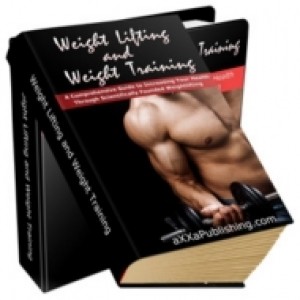 License Type: Private Label Rights
License Type: Private Label Rights  File Size: 8,427 KB
File Size: 8,427 KB File Type: ZIP
File Type: ZIP
 SKU: 3092
SKU: 3092  Shipping: Online Download
Shipping: Online Download
Ebook Sample Content Preview:
To achieve the proper benefit for any given weight lift exercise you must know the proper techniques and do it right. Incorrect lifting technique can work the wrong muscle groups, or worse result in strain or other injuries. The idea of “no pain – no gain” refers to the burn or the tingle you get when you have worked a muscle to the point that will result in its coming back stronger. Weight lifting is not supposed to hurt, and if it does you are either using inappropriate amount of weight or improper technique.
One of the most common weight lifting repetition exercises is the Squat. The Squat, which can be done with Free Weights or Machines, is one of the best weight lifting exercises there is to build lower body and leg strength. The squat is a weight lifting exercise primarily targeting the quadriceps (thigh muscles) and the glutes. (Rear end). But when done correctly it also works out the hamstrings, the calves, and the lower back. Weight lifters have called the Squat “The King of All Exercises” because it works so many muscles at one time and so quickly builds muscle mass. Ironman Tri-Athlete, Ray Fautex says that if you only had 15 minutes a day to do one exercise make it squats.
The squat is done by bending at the knees and hips and lowering the torso between the legs, and then returning to a standing position. The torso should remain as upright as possible during the bend. In doing squats, keep your back straight. Your feet should be about shoulder length apart. Keep your toes pointed forward. Try it a few times with no weight. If it feels difficult you are probably doing it right. It is absolutely critical to keep the back straight during squats or serious injury to the lower back can occur. If you already have a weakened lower back do to injury a weight belt could be worn during squats to help support the lower back. Feet should remain flat on the floor. To maintain proper balance during the upward motion of the squat, force should be exerted from the heel of the foot and not the toes. If squatting with a particularly heavy weight you should use a squat cage, or have a spotter to help you return the barbell to a safe resting position after the squats.
The most common squat is the back squat – were the barbell is held behind the head, across the upper back. But there are dozens of variants. Such as the Hack Squat where the weight is held behind the legs. The Overhead Squat, which is my particular favorite – squatting while holding the barbell at full extension over your head. There are several Squats where you hold the barbell in front of you like the aptly named Front Squat, where it is gripped with your arms folded across your chest, or the Zercher Squat, where it is held in the crook of the arms.
Squatting is a great weight lifting exercise but by its very nature a very rigorous one. It is recommended that a squat be learned from an experienced weight lifter or professional trainer to avoid potential serious injury.
- File Size:8,427 KB
- License: Private Label Rights
- Category:Ebooks
- Tags:2010 Ebooks Private Label Rights








